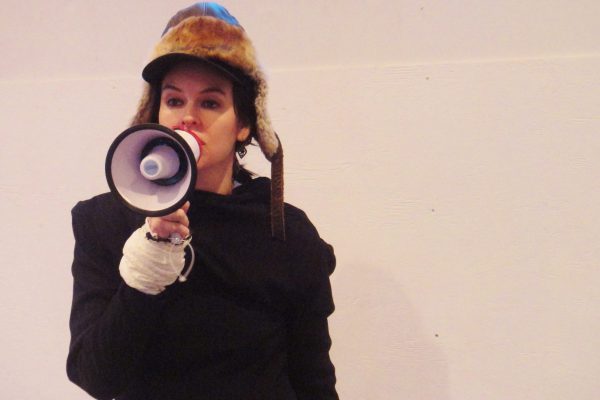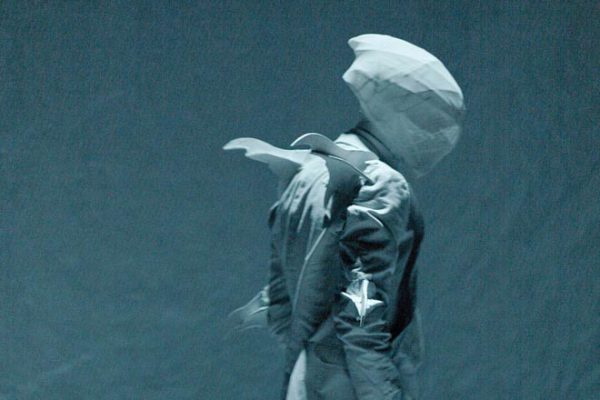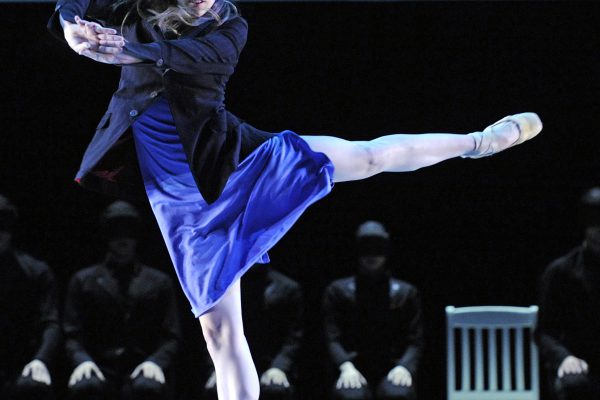“The Negro who, having gone mad from homesickness, was taken home from the World Exhibition and, in his village, surrounded by the lamentations of the tribe, with the most solemn face, by way of tradition and duty, demonstrated the pranks that delighted the European public, who believed they were the rites and customs of Africa.” — Franz Kafka, Blue Octavo Notebooks
“Ville au bout de la route et route prolongeant la ville : ne choisis donc pas l’une ou l’autre, mais l’une et l’autre bien alternées. City at the end of the road and road extending the city: do not choose one or the other, but both alternately.” — Victor Segalen
~
Our particular moment could perhaps be qualified as one of the strides of disjuncture and difference across the country, but perhaps most acutely in Montréal. The reeling effect of recent cultural “incidents” such as Danse Cité’s Souk-Cité 2 and its yellowface sketch, Robert Lepage and Betty Boniface’s showcase of slave spiritual without any black folk participating, last summer’s St. Jean Baptiste celebrations that featured older white patrons in period costumes being pulled by young black men on an “allegorical” float, as they put it, or even the former turgid-grey racist blood sport of Dominic Gagnon’s film Of the North. Yes, we have had no shortages of the strides of disjuncture and difference. Walking in this strange land, we find ourselves trying to find ways in, ways out and ways around, while dancing to the age-old question of “how we culture” and, in our case, “how we dance,” investigations that might offer a real embodied response to, at the very least, address the “morphological” aspects of the particular difficulties of what many critics consider to be our erstwhile hegemonic times.
And within the range of the challenging strides vis-a-vis the “morphological hegemony” we might be facing, the question remains of how to properly represent the disjuncture. One might ask in a very general and rhetorical sense (and the question is formulated from my own bastion within such a grouping, if one can posit such a generalized grouping) how “people of colour” best explore the differences with and among the sometimes shadowy presences speaking for us and on us. How do “we” best represent ourselves among the sometimes “qualifying” gazes seeking to wholly consume us? And in these present moments, when the transgressed scream out “You have spoken about me, on my behalf,” what are the actions taken? And, against the very strides of hubristic assuredness, do we the transgressed attempt to represent our own selves, to be the voice of our own representations? Alas, what a responsibility.
Such are some of the stakes in Claudia Chan Tak’s Bienvenue chez moi, petite Malgache-Chinoise — an installation-cum dance-cum hopeful territory of “spatiotemporal representation” meant, in her own words, to be an “encounter between documentary, cultural identity and animality.” The installation had something of the feel of an Expo 67 pavilion. Roughly translated, the title reads “Welcome to my house, small Chinese-Malaysian girl.” The use of the diminutive and one’s immediate introduction in the installation to her childhood home videos immediately sounded an alarm causing me to ask myself if there is a kind of irony being served here (think of a younger Bowie’s China Girl) in this cultural self-representation. The title seemed ironic — like something flippantly said — kind of belittling, a slight racial reference, not necessarily mean but “playfully racial” (if there is such a thing). But I asked myself: is there a way out or a reappropriation in Chan Tak’s use of irony?
At first, seeing these videos, I thought I might be diving into an environment like the American artist Maggie Lee’s use of video as a transposition of her identity in her 2016 Whitney Museum show, but after moving further into Chan Tak’s space, I became concerned here if there was simply not a sense of “representation as representation” — a sense that the identity being presented was pretty much what was being presented. And, as became clear, we were being led into what seemed to be an immersive environment “identity room” of her Chinese community, including artifacts, home videos, childhood toy animals, paper lanterns and other ephemera regarding her travels to China — travels undertaken in order to understand her roots and connect to memories of her grandfather.
Chan Tak stated, “I wanted to transform a studio space into a personal space.” So yes, here there is an interesting sensitivity to boundary setting. And thus, there was an intention to produce a complex notion of locality, where, as Chan Tak explained, “I could invite people into my own history, in my own home.”
But my concerns regarding existence of or lack of a transposition of identity remained. Although, one cannot deny that Chan Tak did speak about an interesting confrontation that is at the heart of the project. In my interview with her, she explained, “As a little girl … I was more interested in the animal world than understanding my identity in Madagascar. It also made me think about the fact that all my childhood it was easier for me to identify to animals’ characteristics rather than to my cultural roots that were so far away from me but also so absent in the small city I grew up in in Québec.” She continued discussing this interesting thickening of a normative identity narrative and certain guardians she amassed on this journey: “Onstage, the puppies were witnesses and spectators of my identity research but were also moving with me at the end of the show. This time, in the installation, they were watching my childhood memories.” Here, in these descriptions of her work, she attempts to not just represent identity but also transpose identity — to work through the minutiae of the moments between disjuncture and difference, which some might add are so key to moving within our contemporary moment.
The issue remains of how to best find our strides between the moments of disjuncture and difference — how to be true to such a quest of what should not just be a search for personal identity but ultimately one that moves towards more complex forms of social or other facets of identity. There is some traction one can decode in Chan Tak’s intentions, as is evident in her previous interview where she speaks about how displaying photos of the peace sign and dolls of Hello Kitty might transform a stereotype. And, she does admit to part of the installation being about the little girl she once was.
It is worth considering Chan Tak’s larger statement for context:
When I was creating the solo, I was really interested by that “little girl” I found in old family footage of my first travel in Madagascar in 1993 to meet my paternal grandparents. By looking at these images of that seven-year-old little me, I realized that this little girl was more interested in the animals of Madagascar than in the country itself and its people and traditions … I’m playing with the contrast of that little girl that I was and the woman that I became who, I have to say, is sometimes lost and feeling so small in front of the immensity of Chinese and Malagasy culture and history … Honestly, as a second-generation immigrant, I grew up with these stereotypes. They are part of me, of the construction of my own identity. When I was young, I thought liking Hello Kitty was making me more “Chinese,” but then I realized during this creation process that Hello Kitty was in fact Japanese, which is why I created a complete solo Bye Bye Kitty on that discovery that had quite an impact on my identity quest.
But ultimately, during the actual performance and in the midst of the installation, any sense of agency remains volatile and her espousing of cultural identity seems an escape rather than moving through the thoroughfares of the presented “dioramas.” Chan Tak’s search seems stunted and mired in itself for itself. It seems a vacillation but without strong points of anchoring. I watched her emotionally moving short dance. She mingled with her own shadows and demonstrated an appreciation of the capacity of non-humans to act with her amongst
her artifact-filled room. Ultimately, Bienvenue chez moi, petite Malgache-Chinoise did not successfully transform many of the tropes it had attempted to anthropomorphically invoke.
I was left with a question to add to the debate on cultural appropriation: Can we fall prey to the same tropes that they make of “us,” the Other? Could “they” ever represent “us” as well as “we” represent “us”? Alas, now put on pedestals above the problematic and reductive terrain (“they had painted of us”), we wish to present ourselves. Is it not possible that sometimes we “fail” to represent ourselves, that we consume ourselves as ourselves and that our version of ourselves appear as non-rigorously travelled terrains of our own worlds? In those sad moments, our ability to represent our own “local” self, come to see the ability to “represent” the local, is no easy matter even for the local and is a very loaded matter — both by those from outside that local and even by those local to the local, so to speak. As we begin to understand, representing “the local” for anyone is a loaded affair (and not always just a family affair). So how then do we represent ourselves, our own cultures, our own worlds, and still be able to yell out, “This is a transgression (of what you expected)” and only I can do this? Not you, not him, not her, just me.
The recent work of Dana Michel comes to mind. Michel has decided to not show who she is (which it seems to me is in a constant flux), not represent who she is, not show what her culture is, but to implode it from without, to explode it from within. For we learn as we walk down this loaded way of representation and realize that the moment of properly journeying in such self-representations is to start to not just breach the landscape we are describing, but to detourn it, to implode those landscapes, to enter their interiors from the exteriors and to enter the exteriors from the interiors. I suspect there were aspects of this detourn while walking in Chan Tak’s realm of things and objects but perhaps with much of its sentimentalism. There might have not been enough of the crux, the core, the consistent deep song.
Complex interior landscapes of our own “locals” might be the best choice for our present agenda, might be the most important element for attaining the core moments, very special considerations of the interior landscapes of the local, and as the anthropologist Arjun Appadurai has rightfully said, we must see articulations of our localities “as primarily relational than as spatial … as a complex phenomenological quality.”
~
A little goes a long way. Donate to The Dance Current today to support bold and inclusive coverage of dance in Canada.
Tagged: Contemporary, Tangente, QC





